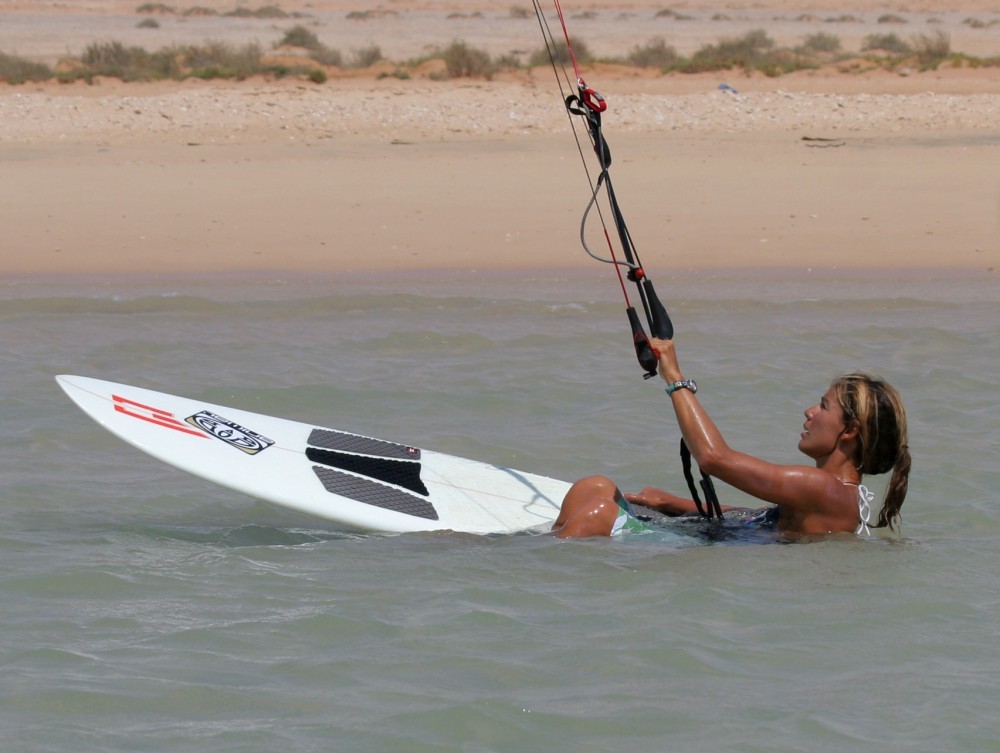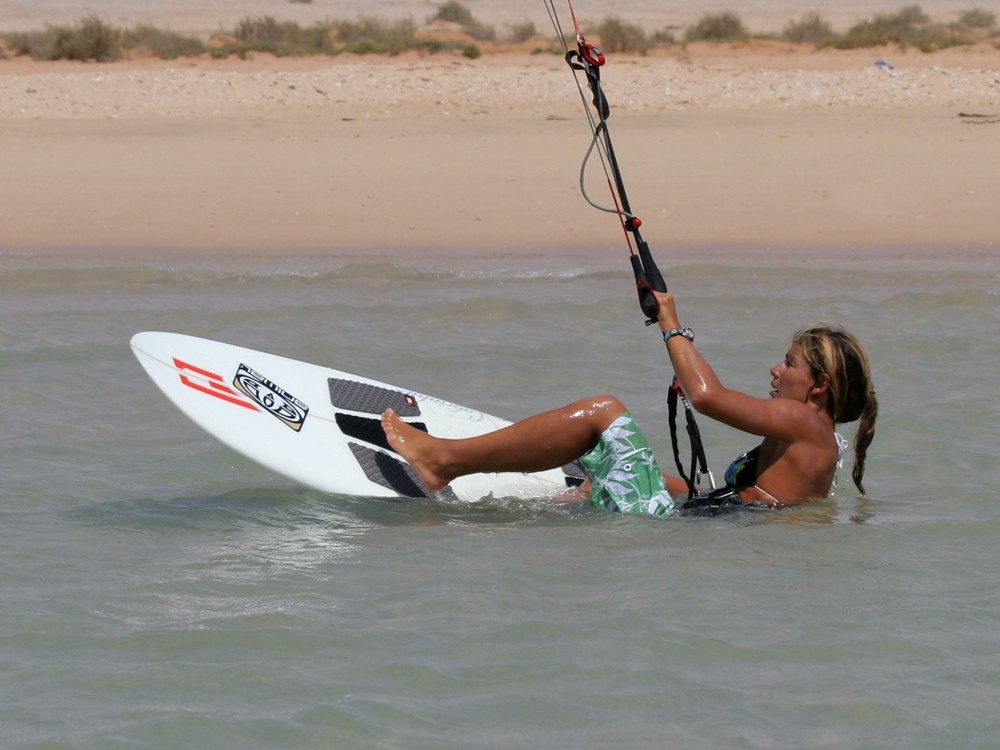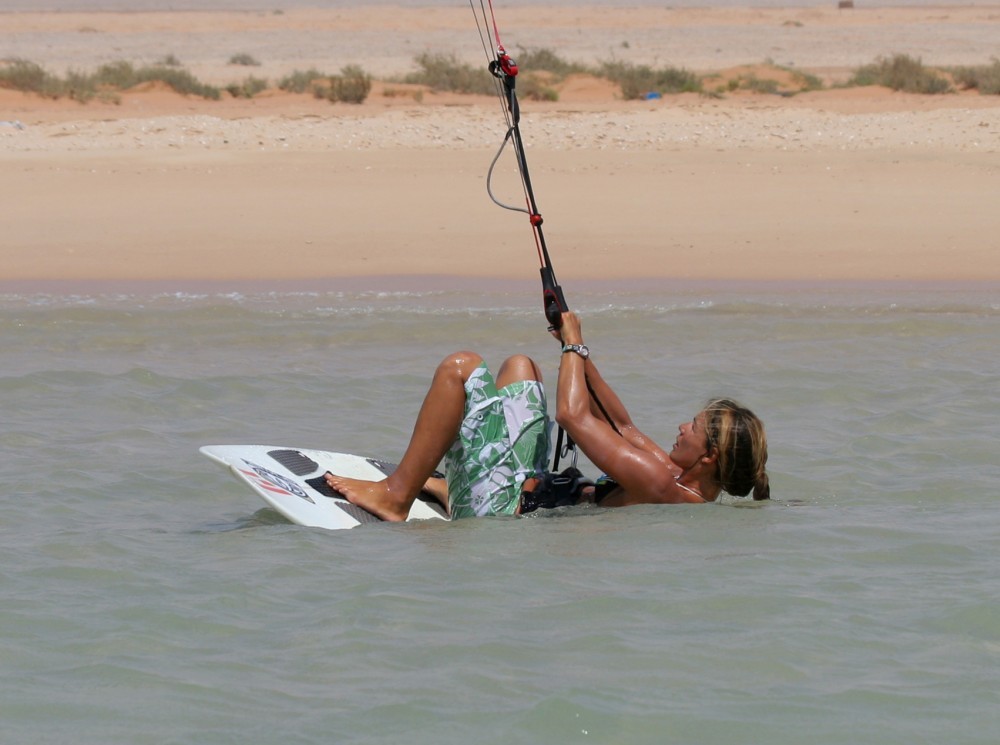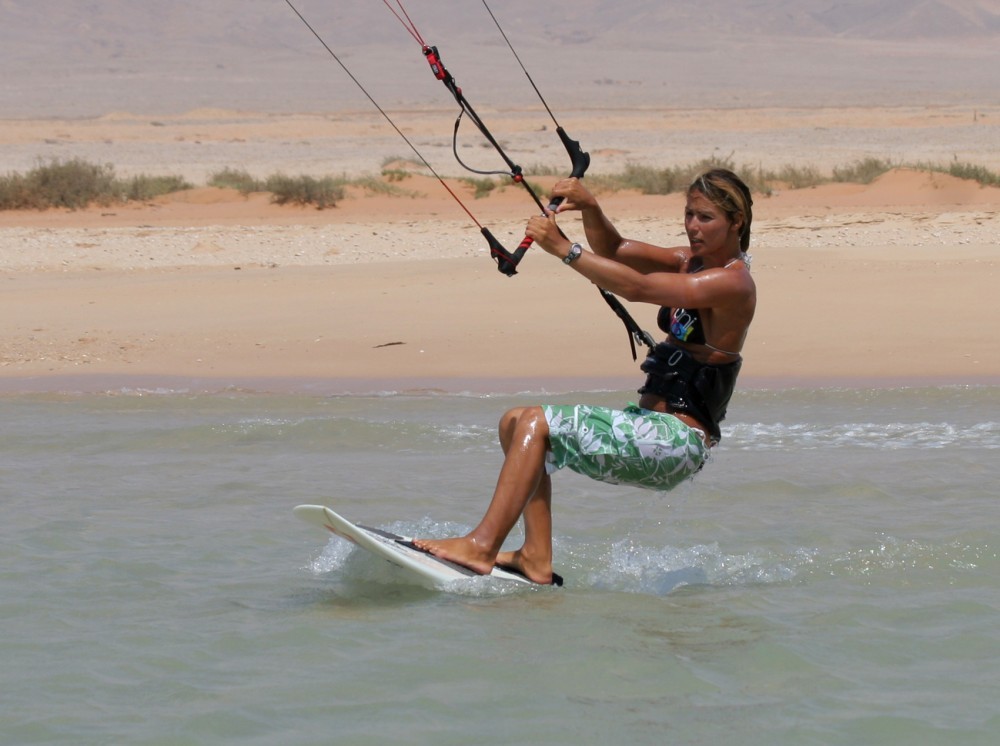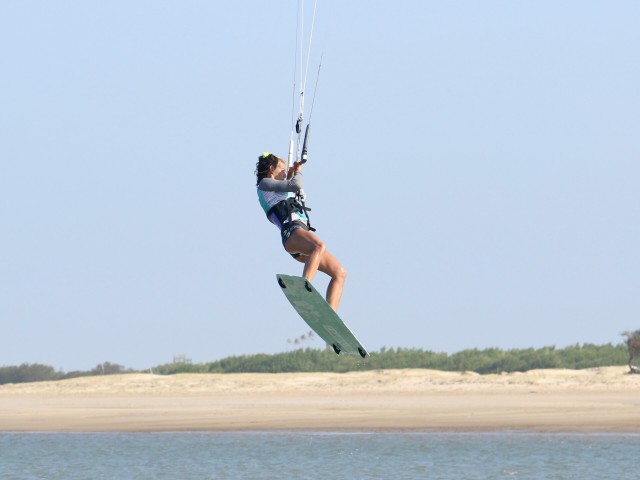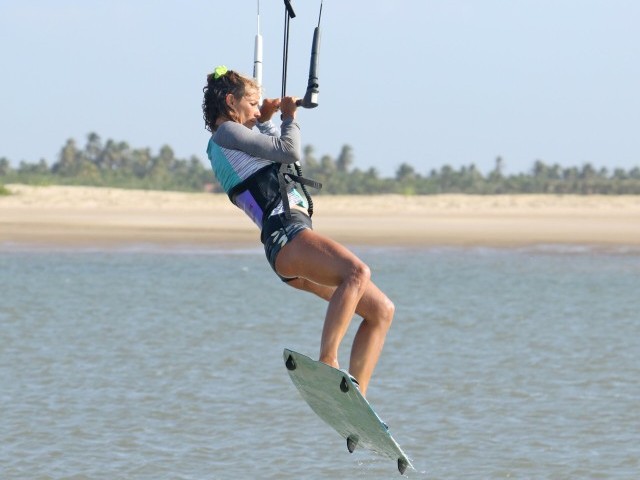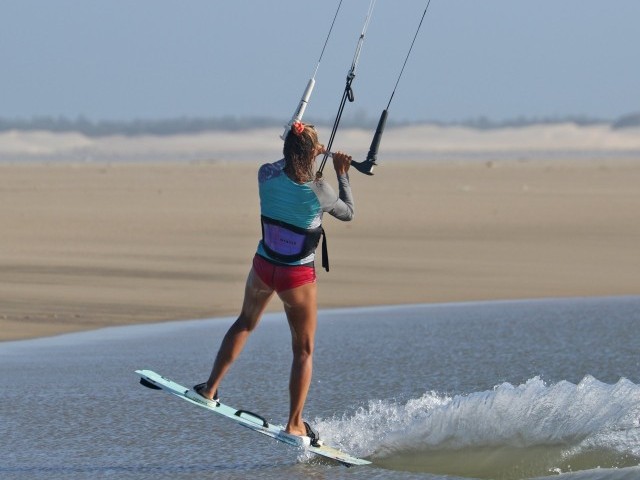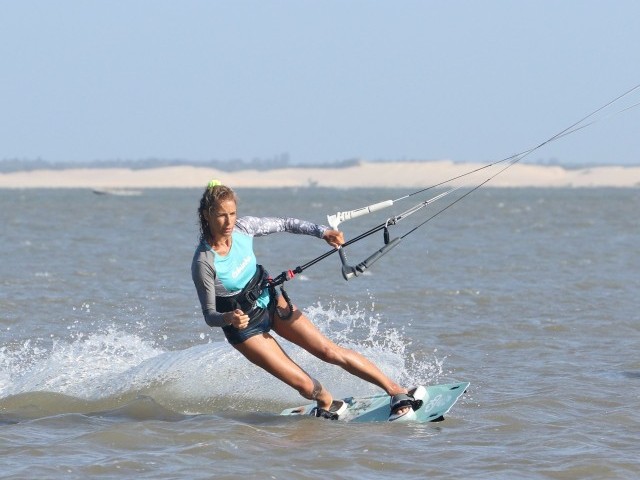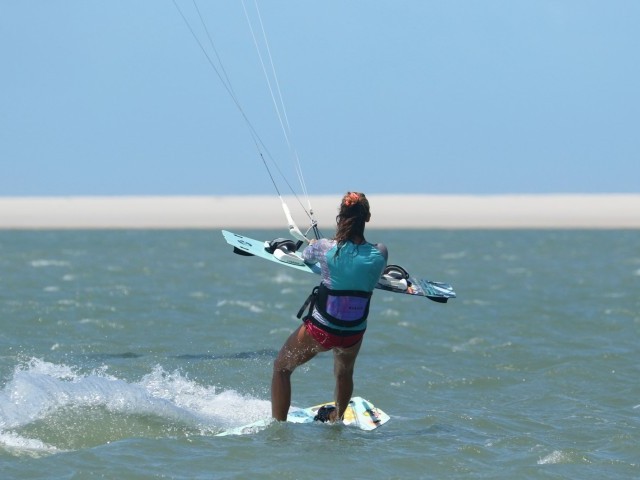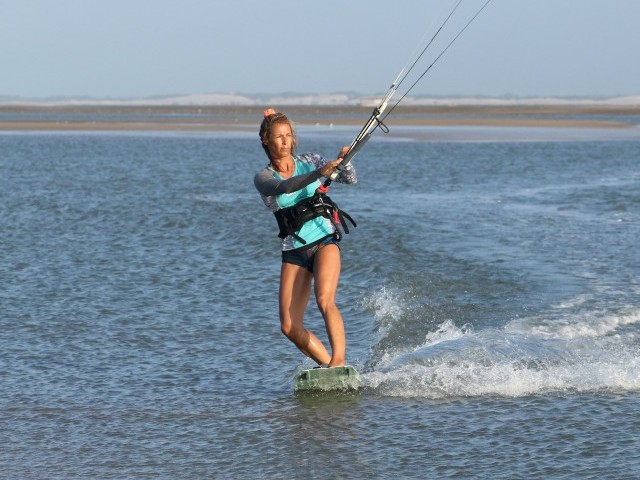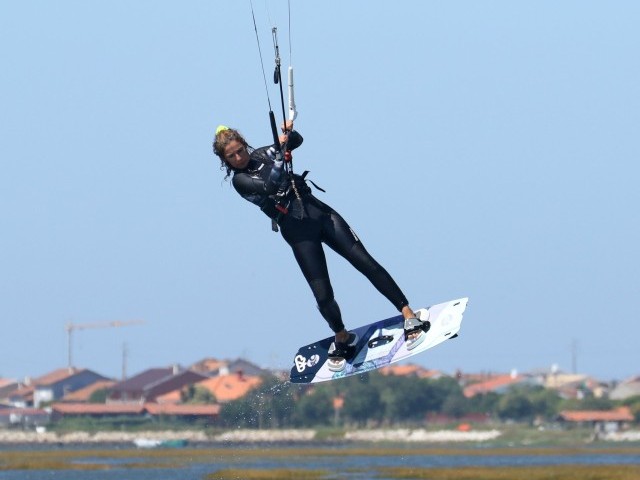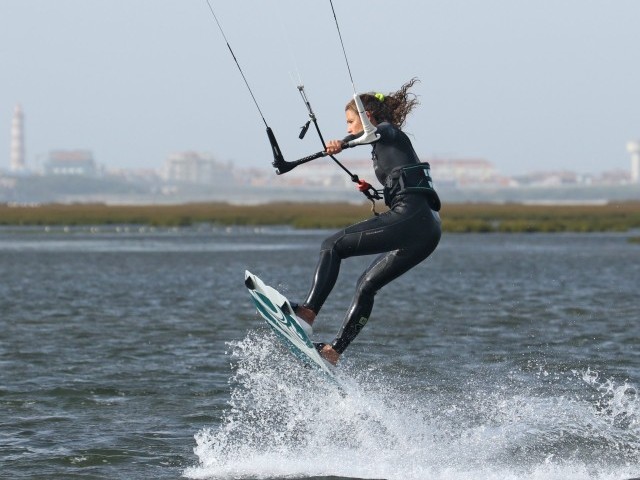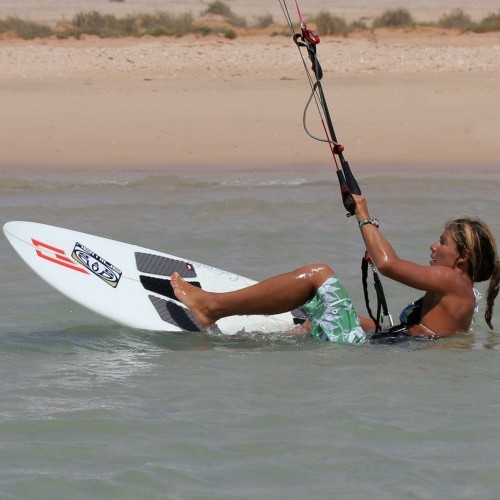
Strapless Water Start
Technique / Beginner
Introduction
Last month during a series of clinics in Egypt, many of our guests often commented on how impressive it looked to be riding around on a surfboard without straps, and of course how much fun it looked even on flat water. On top of this the general consensus was that it must be very difficult. Au contraire mes amis! In fact we could argue that riding a surfboard without straps is potentially easier than riding one with straps, as you have the ability to move your feet around and thus easily change where your weight is on the board. However, more of that in another section. The fact of the matter is its all very good and well, being able to ride a surfboard, but first things first. You do need to be able to get up onto it. Fortunately though this should take very little practice for anyone who can happily water start and ride a twin tip.
As far as boards go, most surf kite boards can be ridden without straps, and these will generally get going easily. However a cheap surfboard in the region of 6 foot will also work, but if it has a lot of rocker (banana shape from nose to tail), it may need a bit more wind to get going. Anything bigger than this is still very rideable, but initially trying to manoeuvre a ten foot long board for your first water start will take more effort.
Realistically there are 4 stages to doing this. First off you’ll need to get control of the board, next you’ll want to get your feet on it, then you’ll change your concentration to the kite and finally you will get up and ride away. So lets have a look at these parts individually and get to grips with what will make each part easier for you.
Grabbing the Board
As a surfboard will have fairly large fins on it, trying to move these around in the water with one hand would be hard. For this reason you’ll always grab the back of the board to get it into position. The best place to grab it is on what will be the toe side or down wind edge. The trick here is to put you hand far enough forward that you have room to lean down on the tail of the board with you elbow. This way as you lean on the board the nose rises, which makes pivoting the board around across the wind and in front of you pretty simple. The final piece to the jigsaw here is to make sure that your elbow is on the heel side, or what will be the upwind side of the board. Like this the board can drift down wind with you. If you dig the other side of the board in, the board will resist and you’ll float into it.
In Pic A. you can see that Karine has taken the board in her right hand, and that she is leaning down on her elbow on the side nearest her. With the board tilted towards her and the nose high, Karine can easily swing the board across in front of her, without getting dragged over it. Much like a twin tip water start, it will be easier to do all of this if the kite is either right above you at 12 o’clock or ever so slightly behind you, the same side as the board, so in these pictures 12.30. If the kite is the opposite side of you than the board you will get pulled away from the board.
Getting Your Feet On
Your front foot will be first, so it’s important that you put it in the right place. Kite surfboards should normally have deck padding, or at least foot strap screw holes, which will give you a rough idea of whereabouts that foot should go. On a surfboard it will be similar to where your front foot would go for surfing. If you’ve never surfed but have a second hand board, look for heel dents or dark wax for a clue. In all honesty once you’re up you’ll soon know if you’ve got them in the right place, or rather in the wrong place.
With the board across in front of you and tilted towards you place your front foot on the board and on the side nearest to you. With the foot nearer the edge and not in the middle the board will stay tilted towards you and aid in getting the back foot on. Once the front foot is in place push the back of the board away from you with you back hand. This will give you space to get your knee up and foot on. Aim to get your back foot on the upwind side of the board too.
In Pic B. Karine’s board is tilted up nicely, so she can easily lift her front leg and therefore foot onto it. In this picture she has also started to push the board away from her with her back hand, which she has moved to the very tail of the board. As long as you push the board away you’ll have plenty of room to get your foot through, even if you’re very inflexible.
Kite Control = Sticky Feet
This part should be a doddle as most of it you’ll have down countless times before. Once you’ve got both your feet on the board, bend your knees right up into your chest, with your bum between your feet This will keep you close to the board, which in turn will make it easier to keep you balance and stay connected to the board. Make sure both feet are on the upwind side of the board. You want your entire foot on the board, not just your heels. If the wind is light, move the kite very gently either side of 12 o’clock, as this will pull you onto the board. If you let the kite float right up above you with no tension in the lines you will feel that the board wants to float away from under your feet. Otherwise keep the bar in and power in the kite, as this will drift you downwind, sticking your feet to the board.
In Pic C. the main thing to notice is Karine’s bar position. Compared to the other pictures she has her bar pulled in to the sweet spot. As already mentioned this power drags her slowly downwind, which sticks her feet to the tilted board. Whereas in the first two phases Karine was trying not to drift downwind too much as that would make controlling the board more difficult as she would be getting pulled over it. You can also see that both her feet are on the upwind side of the board, she is centred between them and ready for action!
Up and Away
There are two types of water start in kiting. Firstly you’ve got the dive your kite madly down, get pulled off downwind and then frantically try to get your kite pointing back up whilst carving hard upwind in an effort to get some tension back in your lines to make the kite finally obey type. And secondly you’ve got the start with the kite behind you, turn it across so that it pulls you up onto the board, and then once you’re up your kite is still high enough that you can dive it down for some extra power type. Hopefully you’ll agree that the later version is best suited to strapless surfboards in the quest for success?
Realistically the idea of coming up onto the board without the kite pulling like mad is preferable when you don’t have any straps to glue the board onto your feet.
In Pic D. Karine is up on the board and heading off in the direction she wants. Karine has kept her weight low by coming up onto the board with both legs bents. If she had straight legs she’d get pulled straight over and off the board. To achieve this she started with her kite at 1 o’clock. This meant that as she turned her kite back by pulling on her front hand, it rose up and over, pulling her up with its lift as it travelled across towards 11 o’clock. This results with her being lifted up onto the board, rather than being pulled across the board. From here she can then continue to dive the kite as it is still high, and as it dives it will pull her forward not down wind. As the kite slowly pulls forward she can adjust her weight and lean back against the kite. If she had dived the kite too aggressively she would have had to lean back early, and with her weight over her back foot she would have turned the board up into wind.
Last Words
In essence the whole shebang is all about having the board in the right place, with the correct power in the kite, and getting comfortable before even trying to get up. Rushing to make it all happen will only make life more difficult. Once everything is in place the actual water start should be fairly effortless.
The conditions you practice this all in will make a huge difference too. If the first time you take a surfboard out, strapless or strapped, is because it’s blowing 25 knots cross onshore with a formidable shore break and some rolling swell you’re in for a baptism of fire. Far better try it all out on a 12m or 10m on flat water to get confident and capable. Just make sure the water is deep enough for the fins!
Following Sequence 1
- Pic 1. Sitting back in the water with her kite at 12 o’clock and as little power in the kite as possible, Karine grabs the back of the board on the far side edge (rail) with her back hand, far enough to give herself enough space to…
- Pic 2. lean down on her elbow to tilt the board towards her and lift the nose. In this position she can swing the board around in front of her.
- Pic 3. Holding the board steady, Karine lifts her front foot onto the board and places it on the near side of the board.
- Pic 4. Now Karine pushes the board away from her with her back hand, keeping the board tilted with her front foot pushing on the upwind edge. This gives her enough room to lift her back foot onto the board.
- Pic 5. Karine reaches up for the bar and pulls it in to get tension in her back lines. With her knees bent right up and her body between them, any pull in the kite keeps the board against her feet.
Following Sequence 2
- Pic 1. Karine very slowly steers the kite back to 1 o’clock.
- Pic 2. Then she quickly steers it back towards 11 o’clock, keeping her knees bent and her derriere between them.
- Pic 3. As the kite passes over Karine, it lifts her up. Karine does not resist and push her feet away but rather goes with the pull and rolls up over the board.
- Pic 4. As she comes up Karine keeps her knees bent and weight low.
- Pic 5. Karine keeps steering the kite down, and with it now pulling from her left she turns and twists her body upwind, which moves her weight back on the board and steers the board across the wind.
- Pic 6. Once comfortable and riding across the wind Karine stands up and steers the kite back up as necessary.
Common Problems
We’ve tried to cover these as we went along, but to recap.
If you’re having trouble getting the board in front of you, chances are that you haven’t tilted it towards you. If the downwind side of the board digs into the water, the board stops whilst you carry on, so effectively you get dragged over it, or away from it.
If you can’t get your back foot on the board. Make sure that your front foot is on the upwind rail so that the board remains tilted. And make sure you push the back of the board as far away from you as possible.
If the board floats away from under your feet. Make sure that both feet are on the upwind edge of the board. This will tilt the board towards you and allow you to get all of each foot down, not just your heels. Pull the bar in so that you drift onto the board and it pushes back.
If the board turns sharply up into wind as you stand up. Try to roll up onto both feet, keeping your body centred between them. Don’t lean back against the power and extend your front leg. Keep your head over your front knee.
Keystones
- Kite at 12 o’clock
- Lean on board with rear elbow
- Tilt board towards you
- Weight on both legs
- Kite from 1 to 11, or 11 to 1 first.
This technique article was in Issue 22 of IKSURFMAG.
Related
By Christian and Karine
Christian and Karine have been working together as a coaching team, running improver to advanced kitesurfing clinics since 2003.








